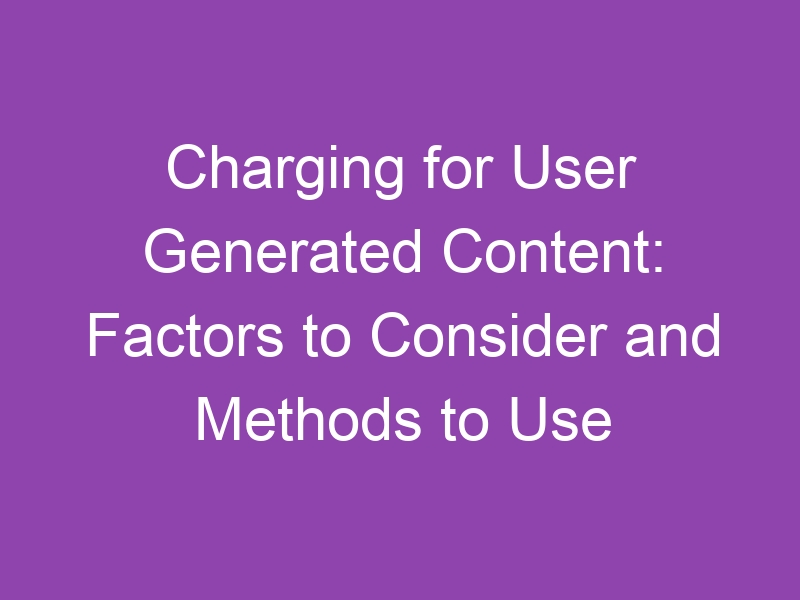Content Outline
- Introduction
- A. Definition of UGC
- B. Importance of UGC
- Benefits of UGC
- A. Builds Trust and Credibility
- B. Increases Engagement and Brand Awareness
- C. Provides Valuable Customer Insights
- D. Saves Time and Resources
- Best Practices for Using UGC
- A. Encourage and Incentivize Customers to Share
- B. Use UGC to Enhance Product Pages
- C. Give Credit Where Credit is Due
- D. Monitor and Moderate UGC
- Conclusion
Introduction
UGC or user-generated content is content created by users of a website or platform, rather than the website or platform itself. It has become increasingly popular in recent years due to the benefits it offers to both users and businesses. In this post, we will explore the various advantages of UGC and how it can be leveraged to improve online engagement and drive brand awareness.
Benefits of UGC
- Increased engagement: UGC can help increase engagement on a website or social media platform by providing users with a sense of ownership and community.
- Cost-effective: Creating content can be expensive, but UGC can help reduce costs by allowing users to create content for free.
- Authenticity: UGC is often seen as more authentic and trustworthy than branded content as it is created by real people with real experiences.
- SEO benefits: UGC can help improve SEO by increasing the amount of user-generated content on a website, which can improve search rankings.
Overall, UGC can be a powerful tool for businesses looking to increase engagement, authenticity, and brand awareness. By leveraging the benefits of UGC, businesses can improve their online presence and drive more traffic to their website.
Introduction – A. Definition of UGC
User-generated content (UGC) refers to any type of content that is created by users of an online platform. This can include text, images, videos, and other types of media. UGC has become increasingly popular in recent years, as more and more people use social media and other online platforms to share their thoughts, opinions, and experiences.
One of the key benefits of UGC is that it can help to create a sense of community and engagement around a particular topic or brand. When users are able to contribute their own content, they are more likely to feel invested in the platform and to continue using it over time.
UGC can also be a powerful tool for brands and businesses, as it allows them to tap into the creativity and enthusiasm of their customers. By encouraging users to share their own experiences with a particular product or service, brands can build trust and credibility with their audience.
However, it is important to note that there are also some potential downsides to UGC. For example, it can be difficult to moderate user-generated content and ensure that it is appropriate for all audiences. Additionally, some users may use UGC as a way to spread misinformation or engage in harmful behavior.
Despite these challenges, the benefits of UGC are clear. By incorporating user-generated content into their online platforms, brands and businesses can create a more engaging and interactive experience for their customers, while also building trust and credibility over time.
Introduction – B. Importance of UGC
UGC or user-generated content refers to any type of content that is created and published by users or consumers of a particular product, service, or platform. UGC comes in various forms such as blog posts, social media posts, reviews, photos, videos, and comments.
The importance of UGC cannot be overstated, especially in today’s digital age where social media and online platforms have become the norm. Here are some of the key benefits of UGC:
- Increased engagement: UGC is more authentic and trustworthy as it comes directly from the users. This, in turn, leads to higher engagement rates as users are more likely to interact with content that they can relate to.
- Improved SEO: UGC can also help improve a website’s SEO as search engines tend to favor content that is fresh, relevant, and user-generated. This means that websites with UGC are likely to rank higher in search engine results pages (SERPs).
- Cost-effective: UGC is a cost-effective way to generate content as it eliminates the need for businesses to create their own content from scratch. This can be especially beneficial for small businesses or startups that may not have the resources to produce high-quality content on their own.
- Increased trust and credibility: UGC can also help establish trust and credibility for a brand or business. This is because users are more likely to trust the opinions and recommendations of their peers rather than the brand itself.
Overall, the benefits of UGC are clear. By leveraging user-generated content, businesses can improve their engagement rates, SEO, and credibility while also saving time and resources.
Sources: Forbes, Social Media Examiner
Benefits of UGC
User-generated content (UGC) is content created by users, rather than brands or companies. There are many benefits to incorporating UGC into your marketing strategy, including:
- Increased engagement: UGC can increase engagement on social media by up to 28%. This is because UGC is seen as more authentic and trustworthy by consumers.
- Cost-effective: UGC is a cost-effective way to create content. Rather than spending money on creating content yourself, you can leverage the content created by your customers.
- Improved SEO: UGC can improve your SEO by increasing the amount of content on your site, as well as improving the freshness and relevance of your content. Additionally, UGC can generate backlinks to your site, which can improve your search engine rankings.
- Increased brand loyalty: By giving customers a voice and allowing them to contribute to your brand, you can increase brand loyalty and advocacy. This is because customers feel a sense of ownership over the brand.
According to a study by Bazaarvoice, 64% of millennials and 53% of baby boomers want brands to offer more ways to share their opinions online. By incorporating UGC into your marketing strategy, you can meet this demand and reap the benefits.
Sources: Business2Community, Bazaarvoice
Benefits of UGC – A. Builds Trust and Credibility
User-generated content (UGC) is any form of content created by users of a system or service. UGC has become increasingly popular in recent years due to its numerous benefits. One of the most significant benefits of UGC is its ability to build trust and credibility among consumers.

Why UGC Builds Trust and Credibility
- Authenticity: UGC provides an authentic view of a brand or product. Consumers are more likely to trust the opinions and experiences of their peers than they are to trust a company’s marketing materials.
- Unbiased: UGC is often unbiased and honest. Consumers can get a real sense of what to expect from a product or service based on the experiences of others.
- Social Proof: UGC provides social proof that a product or service is worth investing in. When consumers see others using and enjoying a product, they are more likely to trust that it is worth their time and money.
Examples of UGC Building Trust and Credibility
One great example of UGC building trust and credibility is TripAdvisor. TripAdvisor is a website that provides user-generated reviews of hotels, restaurants, and other travel-related businesses. Consumers can read reviews from other travelers to get an authentic view of what to expect from a particular business. The website has become a go-to resource for travelers looking to make informed decisions about where to stay and eat while on vacation.
Another example of UGC building trust and credibility is Amazon. Amazon allows customers to leave reviews of products they have purchased. These reviews provide social proof that a particular product is worth the investment. Consumers can read about the experiences of others before making a purchase, which helps them make more informed decisions.
Conclusion
Overall, UGC is a powerful tool for building trust and credibility among consumers. By providing an authentic, unbiased view of a brand or product, UGC can help consumers make more informed decisions and feel confident in their purchases. As more and more consumers turn to UGC as a resource, it is essential for businesses to embrace this trend and incorporate UGC into their marketing strategies.
Source: Business 2 Community
Benefits of UGC – B. Increases Engagement and Brand Awareness
One of the major benefits of User Generated Content (UGC) is the increase in engagement and brand awareness. When users create and share content related to a brand, they are essentially promoting it to their own network of followers and peers. This can result in a snowball effect, where more and more people become aware of the brand through the content that is being shared.
According to a study conducted by Olapic, UGC can increase engagement on social media by up to 28%. This is because UGC is often seen as more authentic and trustworthy than branded content, which can come across as too salesy or promotional. When users share UGC, they are essentially endorsing the brand and its products or services, which can be more powerful than any marketing campaign.
Furthermore, UGC can also increase brand awareness by reaching a wider audience. When users share UGC, they are exposing the brand to people who may not have heard of it before. This can lead to new followers, customers, and ultimately, increased revenue.
Tradeoffs
While there are many benefits to UGC, there are also some tradeoffs to consider. One of the main concerns with UGC is the lack of control that brands have over the content that is being shared. This can be particularly concerning if the content is negative or damaging to the brand’s reputation.
Another potential tradeoff is the time and resources required to curate and manage UGC. Brands need to be actively monitoring social media channels and other online platforms for UGC related to their brand. This can be time-consuming and may require additional staff or outsourcing to a third-party agency.
Conclusion
Overall, the benefits of UGC in terms of increasing engagement and brand awareness outweigh the potential tradeoffs. Brands should embrace UGC as a powerful marketing tool and take steps to manage and curate it effectively.
Sources:
Benefits of UGC – C. Provides Valuable Customer Insights
User-generated content (UGC) has become an increasingly popular way for businesses to engage with their customers and boost their online presence. One of the key benefits of UGC is that it provides valuable customer insights that can be used to improve products and services.
By allowing customers to create and share their own content, businesses gain access to a wealth of information about their customers’ preferences, needs, and opinions. This information can be used to identify patterns and trends, which can be used to inform product development, marketing strategies, and customer service initiatives.
According to a study by Yotpo, a leading provider of UGC marketing solutions, 90% of consumers say that UGC is more influential in their buying decisions than any other form of advertising. This highlights the importance of UGC in gaining insights into customer behavior and preferences.
Some of the valuable insights that can be gained from UGC include:
- Product feedback: Customers will often provide feedback on products they have purchased or used, which can help businesses identify areas for improvement or opportunities for new product development.
- Brand perception: UGC can provide insights into how customers perceive a brand, which can help businesses identify strengths and weaknesses in their branding and marketing strategies.
- Customer needs: UGC can also provide insights into customers’ needs and preferences, which can inform the development of new products and services that better meet these needs.
Overall, the benefits of UGC for gaining valuable customer insights are clear. By leveraging UGC, businesses can gain a deeper understanding of their customers’ preferences and needs, which can inform a wide range of business decisions. To fully capitalize on the benefits of UGC, businesses should implement strategies for encouraging and curating UGC, such as offering incentives for customers to create content and using UGC in marketing campaigns.
Benefits of UGC – D. Saves Time and Resources
One of the key benefits of user-generated content (UGC) is how it can save time and resources for businesses and organizations. By allowing users to create and share content, companies can tap into a vast network of resources that they would not otherwise have access to.
- Reduced content creation costs: With UGC, companies can crowdsource content creation, reducing the need to create content in-house or hire expensive freelancers. This can save businesses significant amounts of money, especially for smaller companies with limited budgets.
- Increased efficiency: When users create content, it frees up time and resources that would otherwise be spent on content creation. This allows businesses to focus on other areas of their operations, such as marketing, customer service, or product development.
- Improved engagement: By allowing users to create and share content, companies can increase engagement with their audience. This can lead to more brand awareness, increased customer loyalty, and even higher conversion rates.
According to a survey by Stackla, user-generated content is 20% more influential on purchasing decisions than any other type of media. This highlights the importance of UGC for businesses looking to connect with their audience and drive sales.
However, it’s important to note that there are also tradeoffs to consider when using UGC. For example, companies must be vigilant in monitoring and moderating user-generated content to ensure it aligns with their brand values and messaging. Additionally, user-generated content may not always be of the highest quality, which can impact the overall perception of a brand.
Overall, the benefits of UGC – including cost savings, increased efficiency, and improved engagement – make it a valuable tool for businesses and organizations looking to connect with their audience and drive growth.
Best Practices for Using UGC
UGC or user-generated content refers to any content that is created by users rather than brands themselves. UGC can come in many forms such as reviews, comments, social media posts, and more.
The Benefits of UGC
UGC can provide a number of benefits for brands such as:
- Increased engagement and social proof
- Improved SEO and search rankings
- Cost-effective marketing
- Insights into customer behavior and preferences
According to a study by Bazaarvoice, over half of consumers trust UGC more than any other form of marketing. In addition, incorporating UGC into your marketing strategy can lead to a 4.5% increase in conversion rates as noted by Yotpo.
Best Practices for Using UGC
When incorporating UGC into your marketing strategy, it’s important to follow these best practices:
- Always ask for permission to use UGC
- Monitor and moderate UGC to ensure quality and appropriateness
- Give proper credit to the creator of the content
- Integrate UGC into your overall marketing strategy and branding
By following these best practices, brands can effectively leverage UGC and reap its many benefits.
Best Practices for Using UGC – A. Encourage and Incentivize Customers to Share
UGC or User-Generated Content is a powerful tool for businesses to increase engagement, build trust, and drive conversions. Encouraging and incentivizing customers to share their experiences and opinions can help businesses harness the power of UGC. Here are some best practices for encouraging and incentivizing UGC:
- Create Contests or Giveaways: Contests or giveaways are an effective way to incentivize users to share UGC. This can include photo or video contests, reviews, or social media posts. According to a survey, 62% of consumers are more likely to share a brand’s photo if there is a chance to win a prize.
- Showcase User-Generated Content: Showcasing UGC on your website or social media channels can encourage other customers to share their experiences. It also creates a sense of community and trust in your brand. According to a study, 90% of consumers say that UGC influences their buying decisions.
- Offer Exclusive Content: Offering exclusive content or early access to products can incentivize users to share UGC. This can include sneak peeks, behind-the-scenes footage, or special promotions. According to a survey, 51% of consumers are more likely to share a brand’s content if it is exclusive.
- Use Hashtags: Using hashtags can help users find and contribute to UGC campaigns. It also makes it easier for businesses to track and measure the success of their UGC campaigns. According to a study, posts with at least one hashtag average 12.6% more engagement.
- Provide Clear Guidelines: Providing clear guidelines and instructions for UGC can encourage more users to participate. This can include specific topics, formats, or brand guidelines. According to a survey, 60% of consumers are more likely to share a brand’s content if they know what is expected of them.
By following these best practices, businesses can encourage and incentivize customers to share UGC, creating a more engaged and loyal customer base. Remember, the benefits of UGC are numerous, including increased engagement, trust, and conversions.
Sources:
Best Practices for Using UGC – B. Use UGC to Enhance Product Pages
One of the best ways to benefit from user-generated content (UGC) is to use it to enhance your product pages. Incorporating UGC on product pages can increase conversions and boost customer engagement. Here are some best practices to follow:
- Showcase product reviews: Include user reviews on your product pages to provide social proof and build trust with potential customers. According to research, 82% of shoppers conduct online research before making a purchase, and product reviews are one of the most important factors they consider.
- Feature user-generated photos: Including photos submitted by customers can help potential buyers visualize how your products look in real life. According to Yotpo, incorporating user photos on product pages can increase conversion rates by 161%.
- Implement Q&A sections: Adding a Q&A section to your product pages can help answer any questions potential customers may have. This can also provide valuable insights into what customers are looking for in your products and help you improve your offerings. According to Bazaarvoice, products with Q&A sections have a 10% higher conversion rate than those without.
By incorporating UGC onto your product pages, you can provide valuable information to potential customers, increase engagement, and ultimately drive conversions. Remember to always monitor and moderate UGC to ensure it aligns with your brand’s messaging and values.
Best Practices for Using UGC – C. Give Credit Where Credit is Due
One of the biggest benefits of user-generated content (UGC) is that it allows brands to showcase their customers, giving them a voice and building trust and loyalty. However, it is important to remember that this content does not belong to the brand, but rather to the users who created it.
Therefore, it is crucial to always give credit where credit is due. This means properly attributing the content to the original creator, whether it be through a tag, mention, or hyperlink. By doing so, brands not only show respect for the creators but also avoid any legal issues that may arise from using content without permission.
According to a study by Stackla, 86% of consumers say authenticity is important when deciding which brands to support. By properly crediting the creators of UGC, brands can enhance the authenticity and transparency of their marketing efforts, leading to increased trust and loyalty from consumers.
Best Practices for Giving Credit to UGC Creators:
- Always ask for permission before using UGC.
- When possible, tag or mention the creator in the post or caption.
- Include the creator’s username or handle in the post or caption.
- When using a photo or video, include a copyright notice or attribution in the corner of the image.
- Link back to the original post or profile of the creator when sharing UGC on social media or other platforms.
By following these best practices, brands can effectively use UGC while still respecting the creators and avoiding any legal issues. This not only benefits the brand but also enhances the overall user experience and builds trust with consumers.
Best Practices for Using UGC – D. Monitor and Moderate UGC
One of the key benefits of user-generated content (UGC) is that it can help to build trust and credibility with your audience. However, it is important to remember that not all UGC is created equal. To ensure that you are getting the most out of your UGC efforts, it is important to monitor and moderate UGC submissions.
- Set clear guidelines for UGC submissions: Before you start soliciting UGC, make sure that you have clear guidelines in place for what is and is not acceptable. This can help to minimize the risk of receiving inappropriate or offensive content.
- Use automated tools to monitor submissions: Depending on the volume of UGC submissions you receive, it may be difficult to manually review each submission. Consider using automated tools to help monitor submissions and flag any that may require further review.
- Assign a dedicated team member to moderate submissions: Even with automated tools in place, it is important to have a dedicated team member responsible for reviewing and approving UGC submissions. This can help to ensure that submissions are being reviewed in a timely and consistent manner.
- Respond to inappropriate content promptly: If you do receive inappropriate or offensive content, it is important to respond promptly. This can help to demonstrate that you take UGC seriously and are committed to maintaining a safe and respectful environment for your audience.
By taking a proactive approach to monitoring and moderating UGC submissions, you can help to maximize the benefits of UGC while minimizing the risks. Remember to always keep your audience in mind and strive to create a positive and engaging experience for them.
For more information on the benefits of UGC, check out this article.
Conclusion
After analyzing the benefits of UGC, it is clear that incorporating it into a marketing strategy can have a positive impact on a business. The benefits include:
- Increased brand awareness through user-generated content sharing and engagement
- Improved search engine optimization through the use of relevant keywords and increased website traffic
- Cost-effective marketing through the use of user-generated content in advertising campaigns
- Improved customer trust and loyalty through social proof and authentic customer experiences
However, it is important to note that there are potential tradeoffs involved in using UGC, such as the risk of negative content or loss of control over brand messaging. It is important for businesses to carefully consider these tradeoffs and develop a strategy to mitigate any potential risks.
Overall, the benefits of UGC cannot be ignored in today’s digital landscape, and businesses that incorporate it into their marketing strategy can reap the rewards.
For more information on the benefits of UGC, check out this Forbes article.



